Page 428 of 650
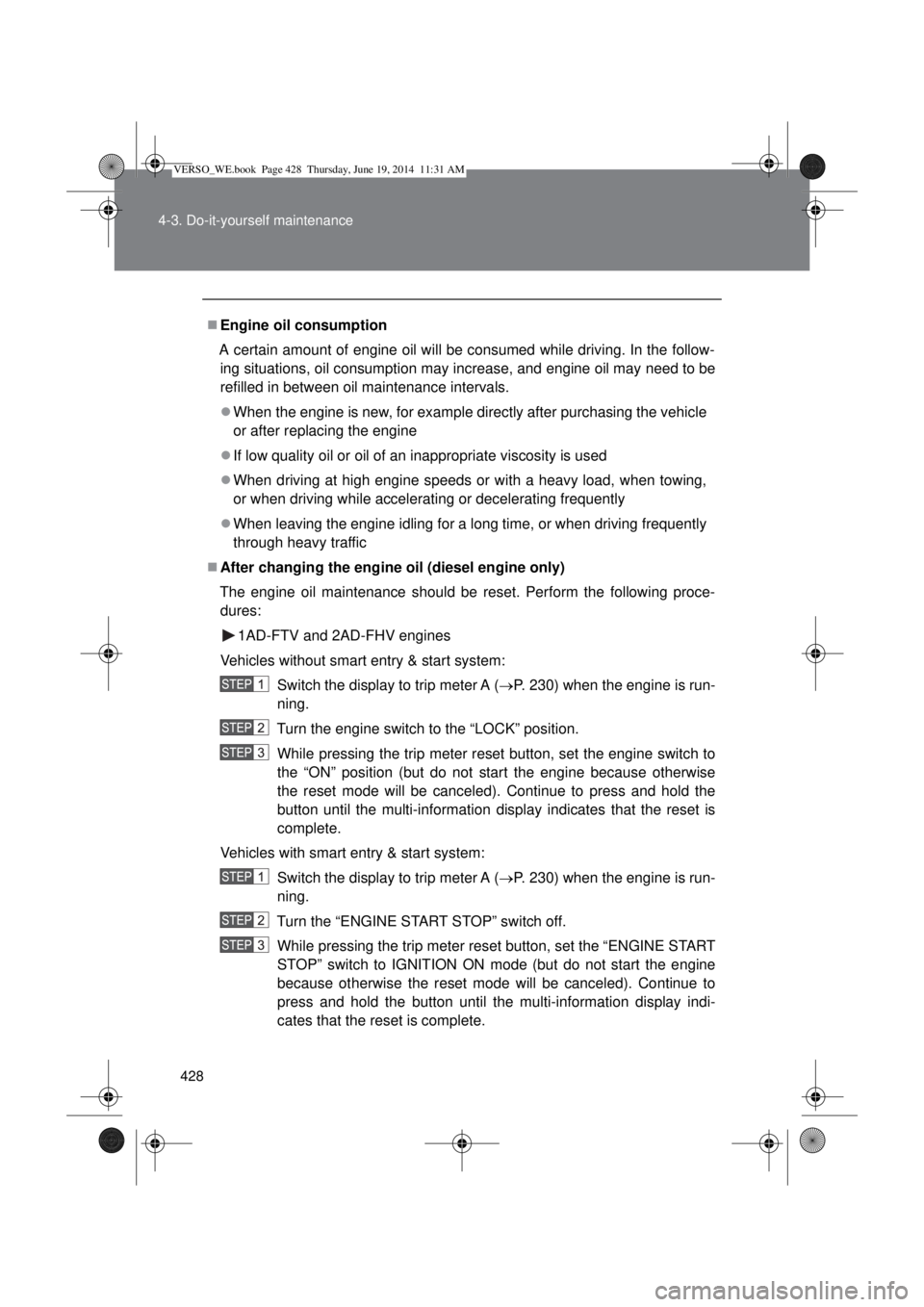
428 4-3. Do-it-yourself maintenance
Engine oil consumption
A certain amount of engine oil will be consumed while driving. In the follow-
ing situations, oil consumption may increase, and engine oil may need to be
refilled in between oil maintenance intervals.
When the engine is new, for example directly after purchasing the vehicle
or after replacing the engine
If low quality oil or oil of an inappropriate viscosity is used
When driving at high engine speeds or with a heavy load, when towing,
or when driving while accelerating or decelerating frequently
When leaving the engine idling for a long time, or when driving frequently
through heavy traffic
After changing the engine oil (diesel engine only)
The engine oil maintenance should be reset. Perform the following proce-
dures:
1AD-FTV and 2AD-FHV engines
Vehicles without smart entry & start system:
Switch the display to trip meter A (P. 230) when the engine is run-
ning.
Turn the engine switch to the “LOCK” position.
While pressing the trip meter reset button, set the engine switch to
the “ON” position (but do not start the engine because otherwise
the reset mode will be canceled). Continue to press and hold the
button until the multi-information display indicates that the reset is
complete.
Vehicles with smart entry & start system:
Switch the display to trip meter A (P. 230) when the engine is run-
ning.
Turn the “ENGINE START STOP” switch off.
While pressing the trip meter reset button, set the “ENGINE START
STOP” switch to IGNITION ON mode (but do not start the engine
because otherwise the reset mode will be canceled). Continue to
press and hold the button until the multi-information display indi-
cates that the reset is complete.
VERSO_WE.book Page 428 Thursday, June 19, 2014 11:31 AM
Page 429 of 650
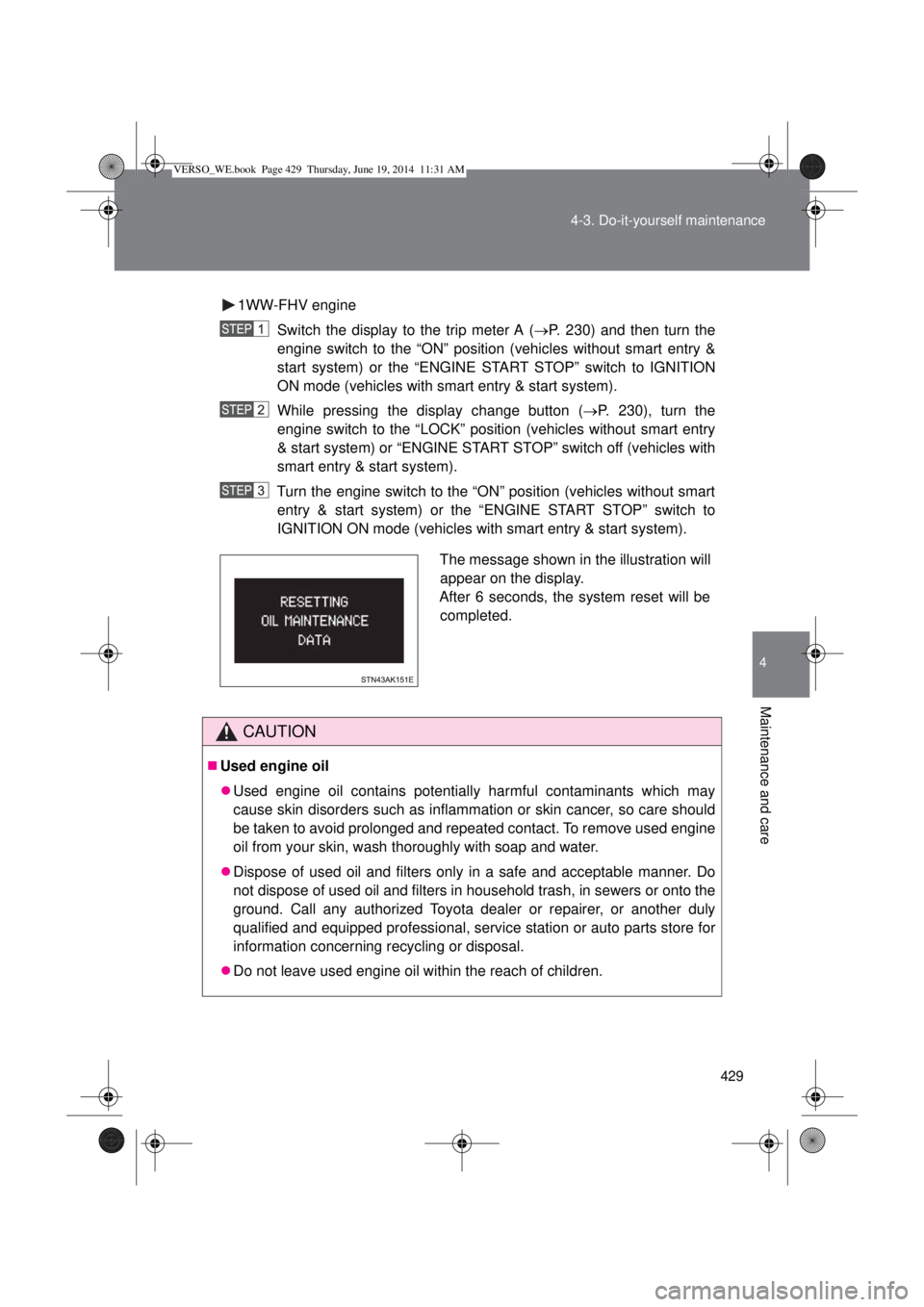
429 4-3. Do-it-yourself maintenance
4
Maintenance and care
1WW-FHV engine
Switch the display to the trip meter A (P. 230) and then turn the
engine switch to the “ON” position (vehicles without smart entry &
start system) or the “ENGINE START STOP” switch to IGNITION
ON mode (vehicles with smart entry & start system).
While pressing the display change button (P. 230), turn the
engine switch to the “LOCK” position (vehicles without smart entry
& start system) or “ENGINE START STOP” switch off (vehicles with
smart entry & start system).
Turn the engine switch to the “ON” position (vehicles without smart
entry & start system) or the “ENGINE START STOP” switch to
IGNITION ON mode (vehicles with smart entry & start system).
CAUTION
Used engine oil
Used engine oil contains potentially harmful contaminants which may
cause skin disorders such as inflammation or skin cancer, so care should
be taken to avoid prolonged and repeated contact. To remove used engine
oil from your skin, wash thoroughly with soap and water.
Dispose of used oil and filters only in a safe and acceptable manner. Do
not dispose of used oil and filters in household trash, in sewers or onto the
ground. Call any authorized Toyota dealer or repairer, or another duly
qualified and equipped professional, service station or auto parts store for
information concerning recycling or disposal.
Do not leave used engine oil within the reach of children.
The message shown in the illustration will
appear on the display.
After 6 seconds, the system reset will be
completed.
VERSO_WE.book Page 429 Thursday, June 19, 2014 11:31 AM
Page 430 of 650
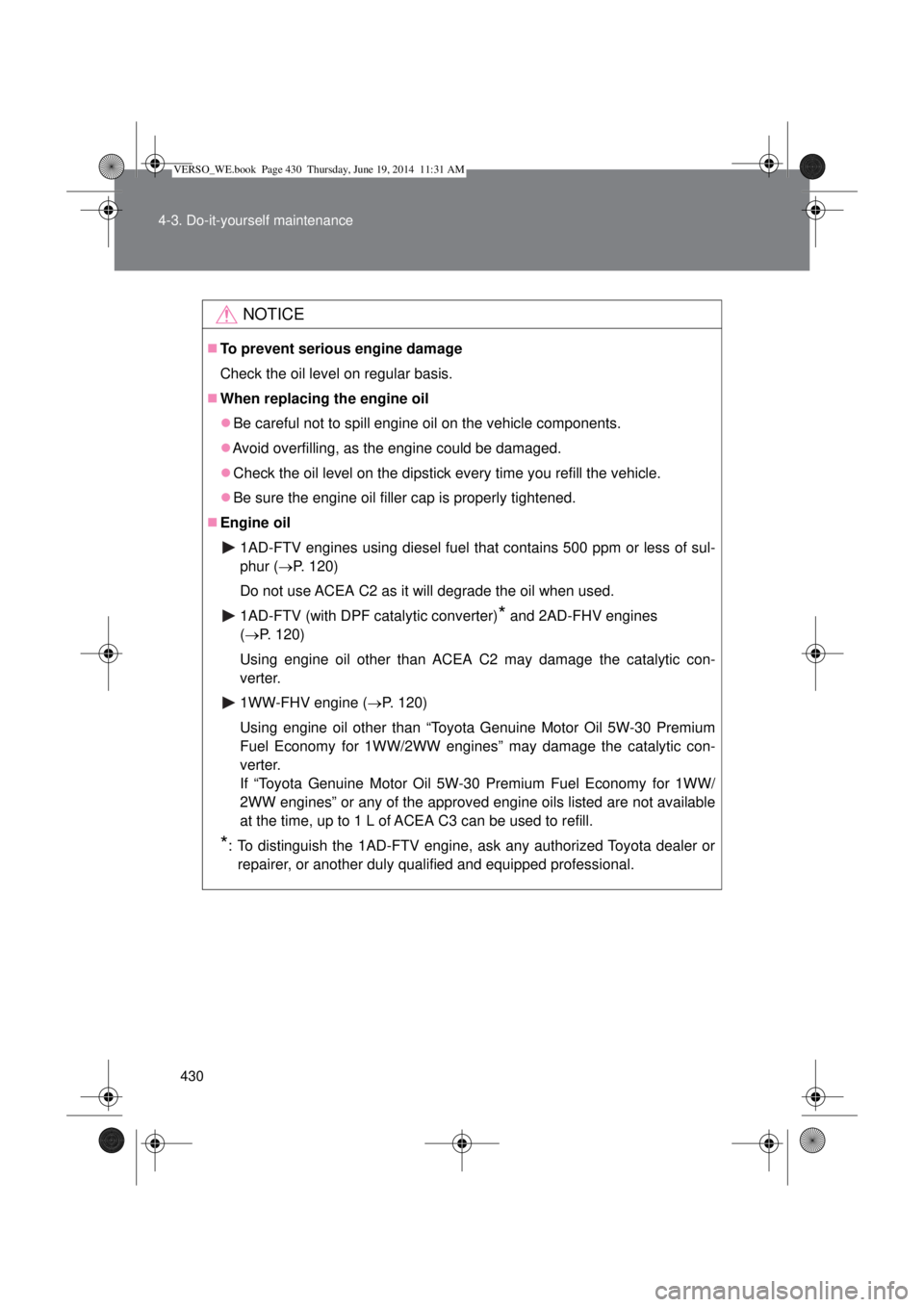
430 4-3. Do-it-yourself maintenance
NOTICE
To prevent serious engine damage
Check the oil level on regular basis.
When replacing the engine oil
Be careful not to spill engine oil on the vehicle components.
Avoid overfilling, as the engine could be damaged.
Check the oil level on the dipstick every time you refill the vehicle.
Be sure the engine oil filler cap is properly tightened.
Engine oil
1AD-FTV engines using diesel fuel that contains 500 ppm or less of sul-
phur (P. 120)
Do not use ACEA C2 as it will degrade the oil when used.
1AD-FTV (with DPF catalytic converter)
* and 2AD-FHV engines
(P. 120)
Using engine oil other than ACEA C2 may damage the catalytic con-
verter.
1WW-FHV engine (P. 120)
Using engine oil other than “Toyota Genuine Motor Oil 5W-30 Premium
Fuel Economy for 1WW/2WW engines” may damage the catalytic con-
verter.
If “Toyota Genuine Motor Oil 5W-30 Premium Fuel Economy for 1WW/
2WW engines” or any of the approved engine oils listed are not available
at the time, up to 1 L of ACEA C3 can be used to refill.
*: To distinguish the 1AD-FTV engine, ask any authorized Toyota dealer or
repairer, or another duly qualified and equipped professional.
VERSO_WE.book Page 430 Thursday, June 19, 2014 11:31 AM
Page 431 of 650
431 4-3. Do-it-yourself maintenance
4
Maintenance and care
Engine coolant
The coolant level is satisfactory if it is between the “FULL” and “LOW”
lines on the reservoir when the engine is cold.
Gasoline engine
Reservoir cap
“FULL”
“LOW”
If the level is on or below the
“LOW” line, add coolant up to the
“FULL” line.
Diesel engine
Reservoir cap
“FULL”
“LOW”
If the level is on or below the
“LOW” line, add coolant up to the
“FULL” line.
VERSO_WE.book Page 431 Thursday, June 19, 2014 11:31 AM
Page 432 of 650
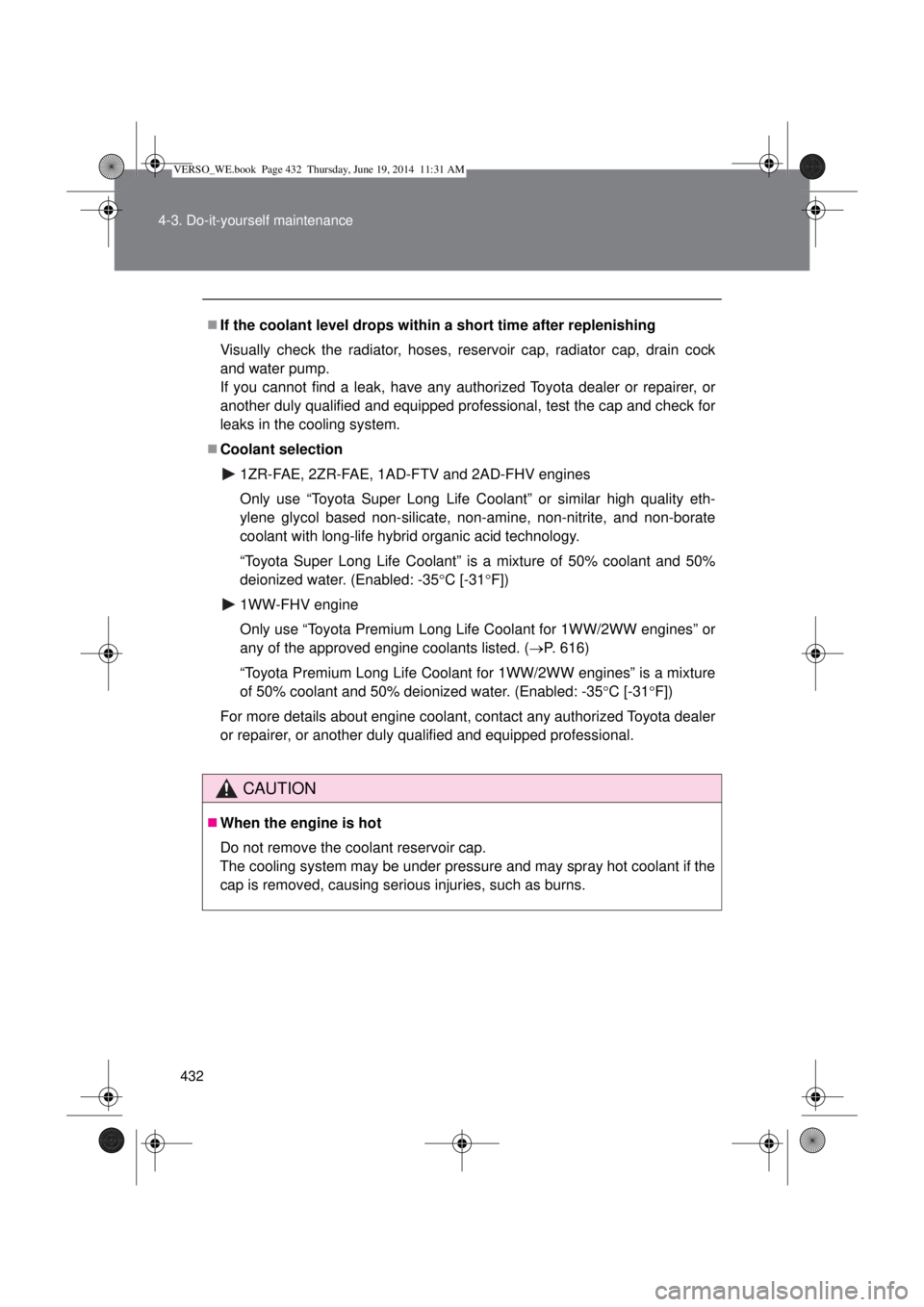
432 4-3. Do-it-yourself maintenance
If the coolant level drops within a short time after replenishing
Visually check the radiator, hoses, reservoir cap, radiator cap, drain cock
and water pump.
If you cannot find a leak, have any authorized Toyota dealer or repairer, or
another duly qualified and equipped professional, test the cap and check for
leaks in the cooling system.
Coolant selection
1ZR-FAE, 2ZR-FAE, 1AD-FTV and 2AD-FHV engines
Only use “Toyota Super Long Life Coolant” or similar high quality eth-
ylene glycol based non-silicate, non-amine, non-nitrite, and non-borate
coolant with long-life hybrid organic acid technology.
“Toyota Super Long Life Coolant” is a mixture of 50% coolant and 50%
deionized water. (Enabled: -35C [-31F])
1WW-FHV engine
Only use “Toyota Premium Long Life Coolant for 1WW/2WW engines” or
any of the approved engine coolants listed. (P. 616)
“Toyota Premium Long Life Coolant for 1WW/2WW engines” is a mixture
of 50% coolant and 50% deionized water. (Enabled: -35C [-31F])
For more details about engine coolant, contact any authorized Toyota dealer
or repairer, or another duly qualified and equipped professional.
CAUTION
When the engine is hot
Do not remove the coolant reservoir cap.
The cooling system may be under pressure and may spray hot coolant if the
cap is removed, causing serious injuries, such as burns.
VERSO_WE.book Page 432 Thursday, June 19, 2014 11:31 AM
Page 433 of 650
433 4-3. Do-it-yourself maintenance
4
Maintenance and care
Radiator, condenser and intercooler
Check the radiator, condenser and intercooler (diesel engine only)
and clear any foreign objects.
If any of the above parts are extremely dirty or you are not sure of
their condition, have your vehicle checked by any authorized Toyota
dealer or repairer, or another duly qualified and equipped profes-
sional.
NOTICE
When adding engine coolant
Coolant is neither plain water nor straight antifreeze. The correct mixture of
water and antifreeze must be used to provide proper lubrication, corrosion
protection and cooling. Be sure to read the antifreeze or coolant label.
If you spill coolant
Be sure to wash it off with water to prevent damage to parts or paint.
CAUTION
When the engine is hot
Do not touch the radiator, condenser or intercooler, as they may be hot and
cause serious injuries, such as burns.
VERSO_WE.book Page 433 Thursday, June 19, 2014 11:31 AM
Page 435 of 650
435 4-3. Do-it-yourself maintenance
4
Maintenance and care
Checking battery fluid (vehicles with gasoline engine)
Check that the level is between
the “MAX” and “MIN” lines.
“MAX” line
“MIN” line
If the fluid level is at or below the
“MIN” line, add distilled water.
Adding distilled water (vehicles with gasoline engine)
Remove the vent plug.
Add distilled water.
If the “MAX” line cannot be seen, check the fluid level by looking
directly at the cell.
Put the vent plug back on and close it securely.
Low O.K.
VERSO_WE.book Page 435 Thursday, June 19, 2014 11:31 AM
Page 436 of 650
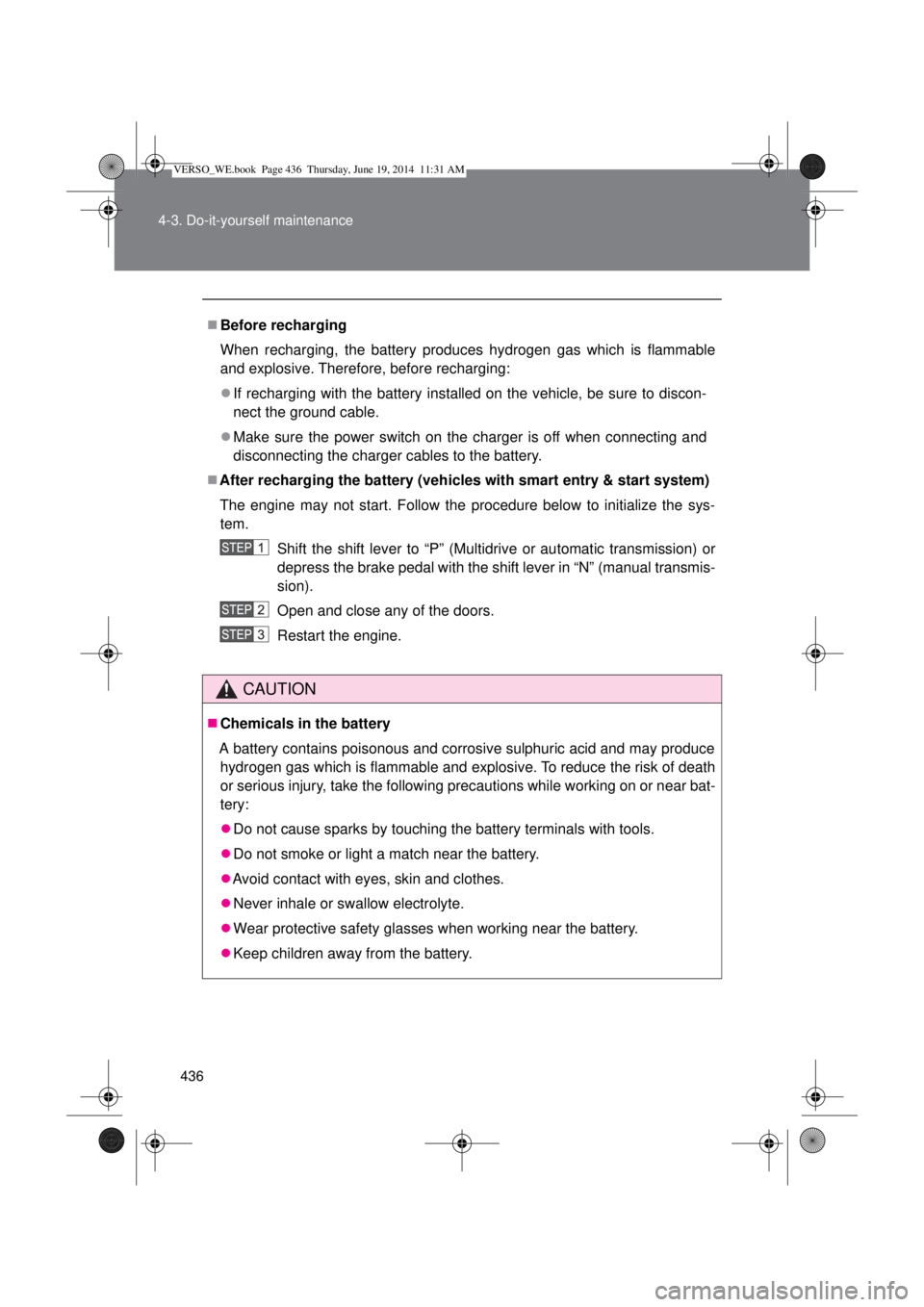
436 4-3. Do-it-yourself maintenance
Before recharging
When recharging, the battery produces hydrogen gas which is flammable
and explosive. Therefore, before recharging:
If recharging with the battery installed on the vehicle, be sure to discon-
nect the ground cable.
Make sure the power switch on the charger is off when connecting and
disconnecting the charger cables to the battery.
After recharging the battery (vehicles with smart entry & start system)
The engine may not start. Follow the procedure below to initialize the sys-
tem.
Shift the shift lever to “P” (Multidrive or automatic transmission) or
depress the brake pedal with the shift lever in “N” (manual transmis-
sion).
Open and close any of the doors.
Restart the engine.
CAUTION
Chemicals in the battery
A battery contains poisonous and corrosive sulphuric acid and may produce
hydrogen gas which is flammable and explosive. To reduce the risk of death
or serious injury, take the following precautions while working on or near bat-
tery:
Do not cause sparks by touching the battery terminals with tools.
Do not smoke or light a match near the battery.
Avoid contact with eyes, skin and clothes.
Never inhale or swallow electrolyte.
Wear protective safety glasses when working near the battery.
Keep children away from the battery.
VERSO_WE.book Page 436 Thursday, June 19, 2014 11:31 AM